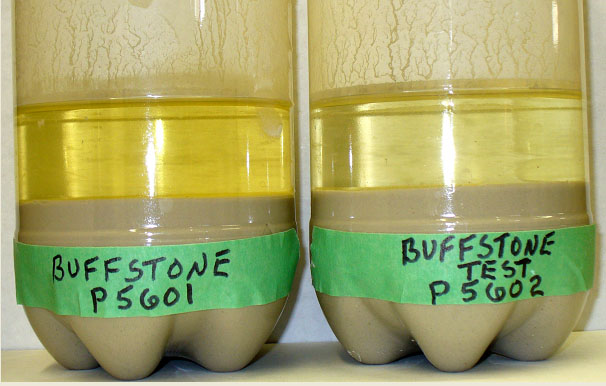| Monthly Tech-Tip | No tracking! No ads! | |
UPSD - Ultimate Particle Size Distribution Test
This refers to ultimate particle size, it cannot be measured by using sieves, the units are microns. Testing equipment or a water sedimentation method must be used.
Typically it is expressed as cumulative undersize, that is, a series of percentage numbers matching a series of successively smaller micron measurements. Each of the numbers is the percentage of particles smaller than the specified micron particle size.
Comparative sedimentation tests in water can be also be done using a minimum of equipment. Where a range of particle sizes are present you can see them as layers after the sedimentation. Of course, a standard method needs to be developed so that each test uses a specific amount of water and clay or mineral powder. Clay powder should be prepared by pulverizing completely dry material so it slakes as much as possible in the water. The suspension should have plenty of water so that particles are free to fall.
Which clay contains more soluble salts?

This picture has its own page with more detail, click here to see it.
Example of sedimentation test to compare soluble salts water extracts from suspended clay. This simple test also reveals ultimate particle size distribution differences in clays that a sieve analysis cannot do.
Can we ball mill a clay and make it more colloidal? Yes.

This picture has its own page with more detail, click here to see it.
This 1000 ml 24 hour sedimentation test compares Plainsman A2 ball clay ground to 10 mesh (left) with that same material ball milled for an hour (right). The 10 mesh designation is a little misleading, those are agglomerates. When it is put into water many of those particles break down releasing the ultimates and it does suspend fairly well. But after 24 hours, not only has it settled completely from the upper section but there is a heavy sediment on the bottom. But with the milled material it has only settled slightly and there is no sediment on the bottom. Clearly, using an industrial attrition ball mill this material could be made completely colloidal.
Variables
VAL - Value (V)
Related Information
Videos
Links
| Tests |
Average Particle Size (Microns)
|
| Tests |
Sieve Analysis 35-325 Wet
A measure of particle size distribution by washing a powdered or slaked sample through a series of successively finer sieves |
| Tests |
Sieve Analysis Dry
A measure of particle size distribution by vibrating a powdered sample through a series of successively finer sieves |
| Glossary |
Ultimate Particles
Utlimate particles of ceramic materials are finer than can be measured even on a 325 mesh screen. These particles are the key players in the physical presence of the material. |
| Glossary |
Slaking
This term is using in ceramics to describe how a dry clay disintegrates when it is immersed in or exposed to water. Different clays have different slaking rates. |
| Typecodes |
Particle Tests
Tests conducted to determine particle populations, sizes, shapes, densities, surface areas, etc. |
| By Tony Hansen Follow me on        |  |
Got a Question?
Buy me a coffee and we can talk

https://digitalfire.com, All Rights Reserved
Privacy Policy
